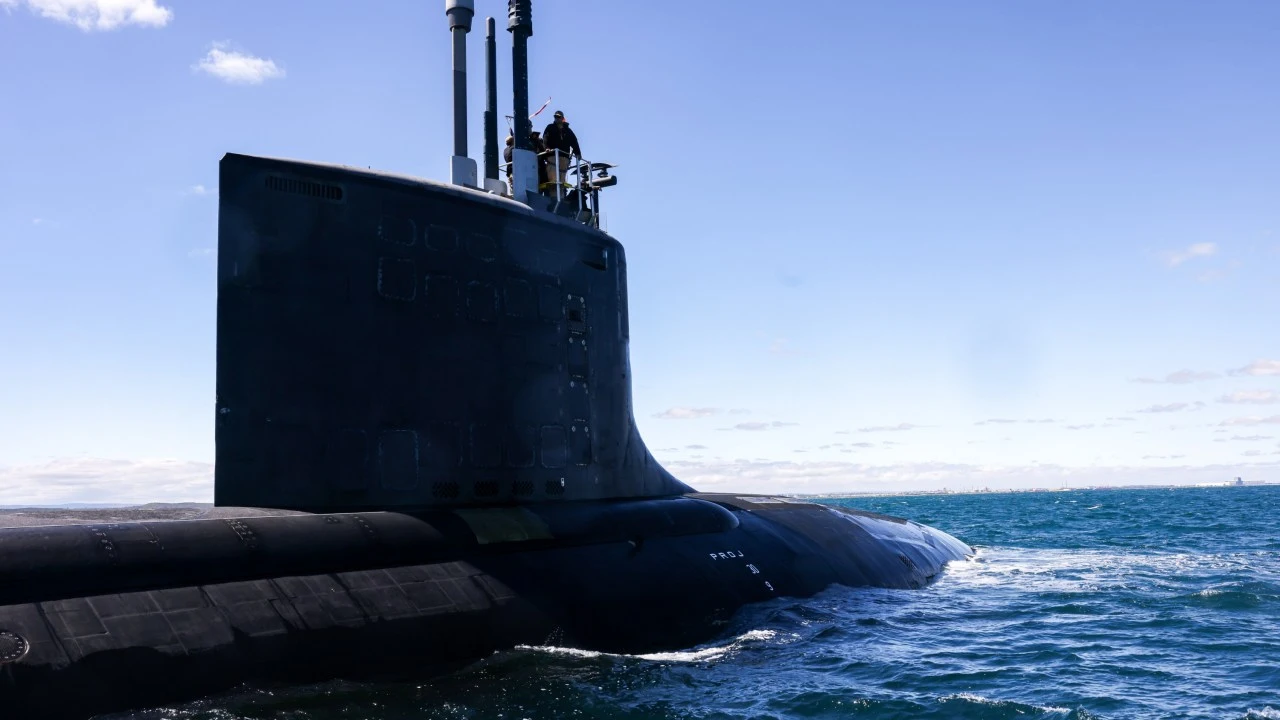‘Valhalla Café’ reads the bold blue and white sign above the kitchen serving area on the USS Minnesota.
The adjacent walls and tables in the crew’s mess area are decorated with framed, high-resolution pictures of longships, Norse Gods and Vikings striding powerfully with weapons at the ready.
In the commanding officer’s state room an ornate axe is fixed to the wall.
The emotive imagery is a reminder I’m told of how Vikings prioritised defence, land and their families.
Near the axe is a hometown ‘Golden Gopher’ gridiron helmet.
On board the USS Hawaii I’d similarly found a miniature war canoe, paddles and flags.

All are examples of how the United States Navy leans into building purpose and connection with the cities, islands and states from which its submarines draw their commemorative names.
It leads one to wonder if Australia will change the names of the boats it will take ownership of under AUKUS from 2032.
To do so is considered unlucky.
But would it also be rude?
At 115m long and with 135 crew, it would be a mistake to simply describe SSN-783 as an attack submarine.
With a new build cost just shy of $5 billion, the Virginia class USS Minnesota represents the ultimate “pause for thought moment” for any enemy.
As its new Commanding Officer, Jeffrey Cornielle put it when questioned: “if someone wakes up and says is today the day? We make sure they say, ‘maybe not!’
“It’s not just important for the United States, it’s important for all of our partners.”
During the Cold War America had a little under 100 nuclear powered attack submarines in its fleet.
The end of the war and promise of an enduring peace saw Washington take its foot off the pedal and the fleet’s numbers diminish.
It is “procuring” new boats, but its current Virginia class builds are well behind schedule.
With a new President, the question of whether Australia will get its three ear-marked Virginias was among the first questions raised.
The commanders’ answer had the deft skill of a lifelong statesman.
“We are working towards it. We are in Pillar One now, we are moving forward,” he said, not shifting in his seat.
“AUKUS aside, one of the biggest things my crew got out of (the visit) was the ability to talk and go out on the town with a sailor from the Collins or the Waller and share sub stories. Because their life is different from our life, and we got to learn firsthand what that is, which I thought was an amazing opportunity. And we will just keep doing that until someone says otherwise.”
There was to be no talk of if the visiting boat was, is or could be nuclear armed.
That is left to others to presuppose.
That said, its conventionally armed Tomahawk missiles can strike an enemy 1600km away.
Around the same distance between Brisbane and Melbourne.
I had travelled by fast transport boat to a location off the West Australian coast to meet up with the Minnesota.
The 40-minute navy ride in sickly waves had seemed anti-climactic when we found the apex predator wasn’t waiting “dead in the water” as promised but missing.
Was it beneath us?
Would it rise from the depths on cue?
Twenty minutes later she steamed in from the glistening horizon, carving through the frothing azure, her flag a flutter as if a stead whistled into position.
A dark smudge at first, the metallic conning tower and scopes seemed to evoke the shape of the statue of the Liberty.
In fewer than 1,000 days Australia hopes to begin permanently hosting a veritable nest of visiting nuclear powered submarines from the US and Great Britain under the tagline of Submarine Rotation Force – West.
In all, five subs and their families will be effectively based out of WA – turning HMAS Stirling into a home-away-from-home of sorts.
“We are in a time now where we have an opportunity to strengthen the alliance in the Indo – Pacific,” said Commander Cornielle, aware that only weeks ago Chinese warships completed an ominous circumnavigation of Australia conducting live fire drills.

We were prevented from filming in the Minnesota’s control room but could observe.
I counted at least 40 screens or monitors abuzz with maps, graphs and information.
With 20 to 30 crew inside, it’s more than double the size and number of the control rooms on each of our six Collins class diesel electric submarines.
“The only limiting factor is food and we bring about 90 days onboard,” US Captain Neil Steinhagen explained before departure.
It’s normally around the same length of time a crew goes without sunlight.
With ages raging from late teens to those in their mid-forties wages are high, and food is made to please.
There’s surf and turf Sundays and Taco Tuesdays.
Saturday night is apparently “movie night” with “pizzas, wings, jalapeño poppers and mozzarella sticks”, all served from the Valhalla Café.
Then there are the burgers for lunch on the days the crew must clean the boat.

Unlike the USS Hawaii, there are no Australian’s serving onboard this boat.
Many of our best however are coming through.
“It’s exciting. I think it brings a lot of energy,” one sailor effused on the topic.
“As of February, I’m told there were 115 Aussies in America’s submarine training program. And 130 more learning to maintain a nuclear vessel.”
Those numbers have helped the US to increase maintenance hours on its boats.
Three submarines in Pearl Harbour are currently undergoing maintenance.
There is no doubt AUKUS, while broadly popular in Australia, has raised eyebrows within America’s ranks.
Captain Steinhagen jovially admitted to initially being one of them.
He commands five submarines out of Guam in the Pacific.
The USS Minnesota is one of them.

“Is it is going to pull resources from Guam? That’s a selfish standpoint,” he said warmly, while conceding his own understandable self-interest in protecting America’s most precious war-fighting assets.
“It is a great outreach,” he said of the upcoming rotation force.
“And we have to get it right.”
For the captain it doesn’t matter which allied nation a submarine comes from, resources and roles are governed by the iron clad laws of arithmetic.
“If a submarine (is down) everyone is affected. It doesn’t matter what flag is on the uniform.”
It’s a good indication of the growing realisation among governments that leaner nations can no longer leave it to Washington.
“Freedom has never been free, it comes at a cost,” Captain Steinhagen, said.
“It just depends on where you want to put those dollars in order to provide safety and security for your nation.”
With Australia heading towards an election, the one seat both parties might find themselves in is the hot seat as they’re left to explain how they will urgently address Australia’s lagging capabilities in what all agree is a far more dangerous world.


